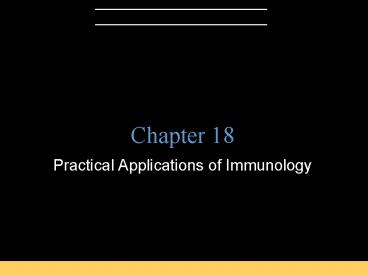Practical Applications of Immunology - PowerPoint PPT Presentation
1 / 18
Title:
Practical Applications of Immunology
Description:
Variolation: Inoculation of smallpox into skin (18th century) ... Pertussis: Acellular fragments of B. pertussis. Tetanus: Purified tetanus toxoid ... – PowerPoint PPT presentation
Number of Views:1405
Avg rating:3.0/5.0
Title: Practical Applications of Immunology
1
Chapter 18
- Practical Applications of Immunology
2
Vaccine History
- Variolation Inoculation of smallpox into skin
(18th century) - Vaccination Inoculation of cowpox into skin
- Herd immunity results when most of a population
is immune to a disease.
3
Principal Vaccines Used in the United States to
Prevent Bacterial Diseases in Humans
- DtaP
- Diphtheria Purified diphtheria toxoid
- Pertussis Acellular fragments of B. pertussis
- Tetanus Purified tetanus toxoid
- Meningococcal meningitis Purified polysaccharide
from N. meningitidis - Haemophilus influenzae type b meningitis
Polysaccharides conjugated with protein - Pneumococcal conjugate vaccine S. pneumoniae
antigens conjugated with protein
4
Principal Vaccines Used in the United States to
Prevent Viral Diseases in Humans
- Smallpox Live vaccinia virus
- Poliomyelitis Inactivated virus
- Rabies Inactivated virus
- Hepatitis A Inactivated virus
- Influenza Inactivated or attenuated virus
- Measles Attenuated virus
- Mumps Attenuated virus
- Rubella Attenuated virus
- Chickenpox Attenuated virus
- Hepatitis B Antigenic fragments (recombinant
vaccine)
5
Precipitation Reactions
- Involve soluble antigens with antibodies
Figure 18.3
6
Agglutination Reactions
- Involve particulate antigens and antibodies
- Antigens may be
- On a cell (direct agglutination)
- Attached to latex spheres (indirect or passive
agglutination)
Figure 18.4
7
Antibody Titer
- Is the concentration of antibodies against a
particular antigen
Figure 18.5
8
Hemagglutination
- Hemagglutination involves agglutination of RBCs.
- Viral hemagglutination inhibition tests for
antibodies by the antibodies' ability to prevent
viruses from agglutinating RBCs.
Figure 18.7
9
Neutralization Reactions
- Eliminate the harmful effect of a virus or
exotoxin
Figure 18.8b
10
Complement Fixation
Figure 18.9.1
11
Complement Fixation
Figure 18.9.2
12
Fluorescent Antibody Techniques (Direct)
Figure 18.10a
13
Fluorescent Antibody Techniques (Indirect)
Figure 18.10b
14
Enzyme-Linked Immunosorbent Assay(Direct ELISA)
Figure 18.12a
15
Enzyme-Linked Immunosorbent Assay (Indirect
ELISA)
Figure 18.12b
16
Serological Tests
Figure 18.13
17
Serological Tests
- Direct tests detect antigens (from patient
sample) - Indirect tests detect antibodies (in patient's
serum)
18
Serological Tests
- Agglutination Particulate antigens
- Hemagglutination Agglutination of RBCs
- Precipitation Soluble antigens
- Fluorescent-antibody technique Antibodies linked
to fluorescent dye - Complement fixation RBCs are indicator
- Neutralization Inactivates toxin or virus
- ELISA Peroxidase enzyme is the indicator

